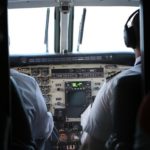We are our own worst enemies in shaping the image of our industry’s future, says Alan Peaford. Here’s what needs to change.
I was asked recently by the parent of a wannabe pilot how to dissuade the young lady from taking up her dream of a career with a commercial airline.
“Surely, she will be out of a job in a few years once self-flying aircraft start operations and it is so expensive,” she told me.
Of course, I did my best to change her view, but it does seem as if we are our own worst enemies in shaping the image of our industry’s future.
And this is not only about pilots. Our entire industry faces severe challenges if we cannot persuade young people today that a career in the aerospace sector is worth having.
We need engineers and technicians; we need designers and programmers; we need creative managers and visionaries – we need a whole raft of bright new talent.
Boeing predicts
Boeing – who of course has a vested interest in ensuring there are sufficient people to drive and maintain the 41,000 new aircraft it predicts are needed over the next 20 years for increasing passenger and cargo airline demand – says 637,000 pilots alone will be needed with the Asia Pacific region leading the worldwide growth in demand, with a requirement for 253,000 new pilots. North America will require 117,000, Europe 106,000, the Middle East 63,000, Latin America 52,000, Africa 24,000 and CIS / Russia 22,000. It sees demand for 648,000 technicians and 839,000 cabin crew.
It doesn’t reveal how many engineers it needs to keep the production lines moving; nor how many people the engine makers, the tier one suppliers for avionics and aerostructures, the seat-makers and the cabinet makers, will also need to make the growth happen.
Unmanned systems
And don’t think the move towards unmanned technology is without problems. The US military is facing its own shortage of pilots, not just for its regular flying machines, but also for its drones, with the US government looking to increase the amount of “golden hello” and loyalty bonuses it pays to retain and recruit drone operators.
What about the cost argument then? Historically, the military was the supply chain for commercial pilots. As the military reduces numbers – and itself struggles to recruit – the major airlines turned to smaller regional feeder airlines who struggle to operate and the end result is the cost being passed back to the wannabe pilot. My friend’s daughter will be looking at a bill of around $100-£150,000 over a two-year training period before she steps into the right hand seat of a commercial jet. Even then there is no guarantee of a job, as some low-cost airlines “rent” that seat the pilot so as they can reach the 1,500 hours needed to get their type rating.
In many countries there are no tax deductions and some even have VAT added.
Better than video games
Surely, this has to stop. While there are imaginative “re-mortgaging” deals being offered by training schools?
“There is a responsibility for the airlines to recruit the best potential pilots not just those from the wealthiest families.”
The remuneration should also be great enough to reward the pilots themselves for having taken the financial risk to support the airlines’ ambitious plans.
Engineers, technicians and designers also need to see they are joining an industry that is better than the video-game companies can offer.
That could need regulators to look at the training systems they currently endorse. Boeing recently opened a new training wing near London’s Gatwick Airport for technicians and pilots. Looking to fill some of the void itself, Boeing has invested in new training technology that is closer to the training techniques used by the new generation of recruits.
The problem is that the requirement of regulators differs from the current system. For example, the regulator may require a fixed time of say 32 hours on a particular subject. New training methods may reach the same levels of competency in say 20 hours, meaning another 12 training hours are spent on useless work.
This industry will survive the challenge.
Thinking different
There will be self-flying aircraft, but a pilotless 737 or A320 is unlikely over the next two decades. Indeed, just 17% of people say they would board a plane lacking a human pilot according to a recent survey done by UBS.
But that doesn’t stop the need for the out-of-the box thinking that can make changes – and for that we need people. We also need the out-of-the-box thinking that pilots use in a crisis and save lives from otherwise stricken aircraft.
There needs to be more investment in people, and more recognition by regulators that training methods and learning skills are changing, and as an industry as a whole we need to talk up the things that make this a great business to be in.
“As an industry as a whole we need to talk up the things that make this a great business to be in.”
97% of the world’s pilot community is male. There is a huge gap. Some of the best pilots I have flown with are women. We need to do more to encourage women to believe there is an important opportunity for them in aerospace.
And I sincerely hope that my friend’s daughter is one of them.

